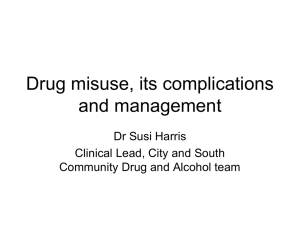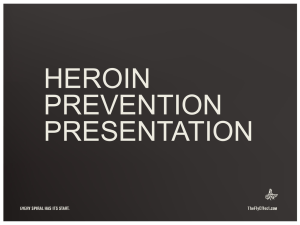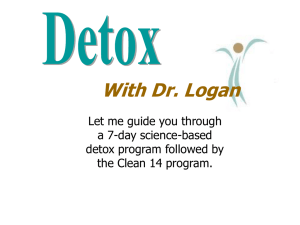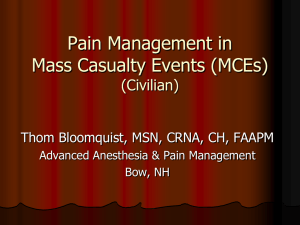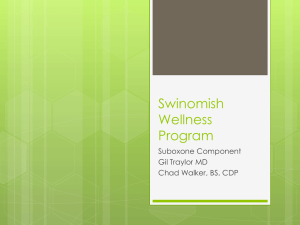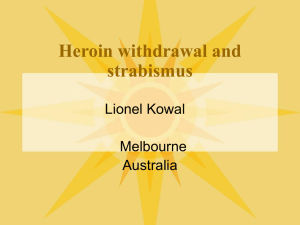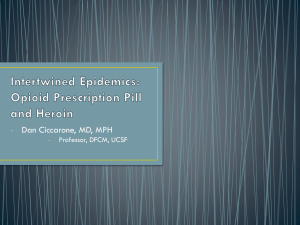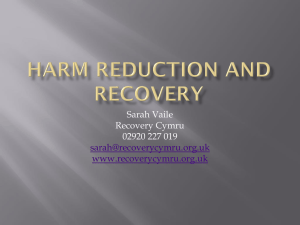RCKC Buprenorphine Program Evaluation – Dennis
advertisement
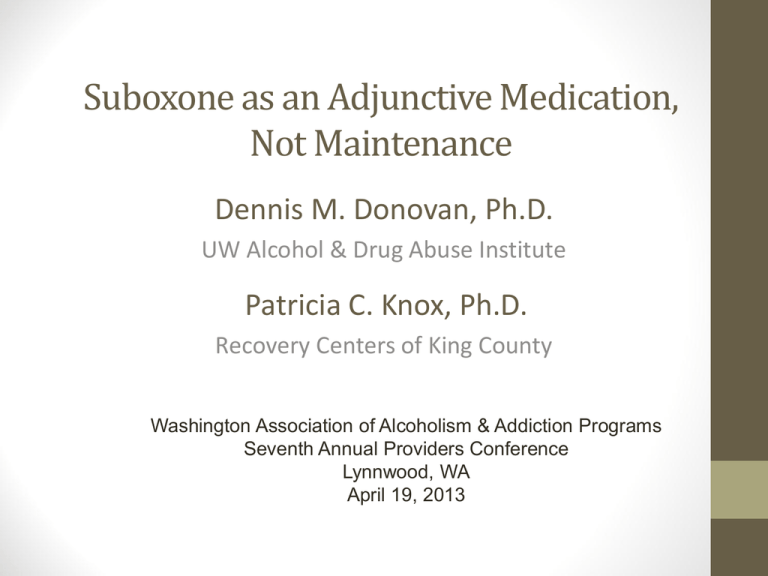
Suboxone as an Adjunctive Medication, Not Maintenance Dennis M. Donovan, Ph.D. UW Alcohol & Drug Abuse Institute Patricia C. Knox, Ph.D. Recovery Centers of King County Washington Association of Alcoholism & Addiction Programs Seventh Annual Providers Conference Lynnwood, WA April 19, 2013 Getting Heroin Dependent Individuals to Enter and Engage in Drug-free Treatment is Problematic • Primary heroin users, compared to other drug users, are significantly less likely to enter the drug-free treatment programs to which they are referred and are less likely to complete residential programs that they do enter • Injection opiate users are at high risk for leaving detoxification against medical advice, failing to avail themselves to treatment and having multiple subsequent readmissions for detoxification • There are high rates of relapse following inpatient detoxification and drug-free treatment among opiate dependent individuals, often occurring shortly after discharge A Need to Facilitate Treatment Engagement and Retention • Those opiate dependent individuals who have abstinence as a goal (e.g., neither using opiates nor on methadone maintenance) are much more likely to achieve and maintain abstinence and delay a relapse, if it does occur, if they have completed an inpatient treatment program followed by involvement in an aftercare program • Thus, it is important to explore methods to increase the likelihood of post-detoxification inpatient treatment entry, engagement, and completion, as well as to enhance the transition to aftercare services for opiate dependent individuals who have abstinence as their goal Where to Begin the Engagement Process? • Inpatient medication-assisted detoxification, typically the first step in the treatment of opiate dependence, represents the point in the continuum of care at which such recommendations might be initiated. Prior Research as Foundation • Prior research by Caldiero and colleagues (2006) compared heroin addicts who were either inducted onto buprenorphine/naloxone (Bup/Nx) as the initial step of an office-based maintenance treatment program or were detoxified through a medication taper protocol first step or were • Both groups were referred to the same treatment program for intensive outpatient treatment and subsequent aftercare following their discharge from the detoxification unit. • Bup/Nx induction and maintenance group was significantly more likely to enter into and had significantly longer stays in the intensive outpatient treatment and aftercare. • The authors suggested that buprenorphine induction in and maintenance beyond detox may represent an effective way of facilitating entry and retention of opiate dependent individuals in more comprehensive treatment Present Evaluation Process • Evaluated RCKC’s feasibility/demonstration project that inducted individuals onto Bup/Nx while in residential detox and maintained them while transitioning into/through intensive inpatient treatment (IIP), with a gradual taper over the course of 5 months of subsequent outpatient aftercare • The objectives of the program evaluation were to: • (1) evaluate the impact of Bup/Nx induction during detox on post-detox referrals to, admission into, and completion of IIP, on OP treatment retention following IIP, and on repeat detoxification admissions by comparing referral, retention, and readmission rates of BTP participants to RCKC historical program norms • (2) explore variables that might differentiate BTP completers from non-completers Patient flow across phases of RCKC continuum of care for heroin dependent individuals admitted to detox in the 1-year period prior to implementation of the BTP (3/1/2008 – 2/28/2009). Patient Characteristics Demographics • 78% Caucasian • Mean age = 36.3 68% male Mean education = 11.5 years Employment • 2% working full time • 59% unemployed/not seeking work • 22% unemployed/seeking work Income • • • • Median monthly income = $339 52% had public assistance a primary source of income 14% received disability income 27% had no primary source of income Housing • 44% were homeless • 18% had no stable living situation Participants’ Substance Use History Mean age of first drug use = 15.5 years old • 68% started alcohol or drug use between ages of 13 -17 Most common first substances Alcohol = 27.5% Heroin = 9.9% Tobacco = 22.0% Cocaine = 8.8% Marijuana = 12.1% Mean age of first heroin use = 23.3 years old Most common drugs used concurrently with heroin Cocaine = 58.6% Stimulants = 33.7% Marijuana = 51.2% Alcohol = 45.3% • 90.9% strongly agreed that their drug problem was serious • 93.8% stated their goal was to achieve/maintain abstinence • 15.5% had prior use of prescribed opiate substitution treatment BTP participant flow across phases of RCKC continuum of care (3/1/2009 – 12/31/2011). Indicators of Treatment Engagement Pre- and Post-Implementation Pre-Period Engagement Indicators Heroin referrals from detox to IIP (N) % Increase from pre Heroin patients admitted to IIP (N) % Increase from pre IIP discharge to OP aftercare (N) % Increase from pre Post-Implementation Periods 3/1/08 2/28/09 3/1/09 2/28/10 3/1/10 – 2/28/11 3/1/11 – 12/31/11 18 28 55.6% 37 105.6% 29 61.1% (35) (94.4%) 49 88 79.6% 92 87.8% 96 95.9% (115) (134.7%) 33 82 148.5% 84 154.5% 63 100.0% (76) (130.0%) Indicators of Treatment Engagement Pre- and Post-Implementation Pre-Period Engagement Indicators Mean OP length of stay (N) % increase from pre Mean times admitted to detox (N) % decrease from pre Post-Implementation Periods 3/1/08 2/28/09 3/1/09 2/28/10 3/1/10 – 2/28/11 3/1/11 – 12/31/11 72 days 103 days 43.1% 114 days 58.3% 115 days 59.7% 1.3 1.1 15.4% Variables Differentiating BTP Completers and Non-completers at a Significant or Trend Level Continuous variables NonCompleters (N = 62) Completers (N = 29) F p Age 37.7 33.28 3.05 .084 Monthly income $316 $191 4.33 .040 Total lifetime drugs used 3.23 4.48 3.32 .072 Difficulty staying abstinent over next 3 months 1 3.79 3.10 3.00 .087 Amount of help needed to remain abstinent over next 3 months 2 3.13 2.21 6.25 .014 1 2 Difficulty remaining abstinent: 1 = very difficult, 7 = not at all difficult Amount of help needed to remain abstinent: 1 = a lot of help, 7 = no help at all Variables Differentiating BTP Completers and Non-completers at a Significant or Trend Level Dichotomous variables NonCompleters (N = 62) Completers (N = 29) X2 p Alcohol user 52.6% 31.0% 3.62 .057 Cocaine user 67.2% 41.4% 5.33 .021 Relapsed during treatment 83.3% 45.8% 7.38 .007 Summary • Results suggest that induction onto Bup/Nx while in detox rather than tapering off for heroin users with a goal of abstinence appears to increase initial treatment engagement and retention across the continuum of care as reflected by: • • • • • Increased referral of heroin users from detox to inpatient Increased rates completion of IIP Increased rates if referral from IIP to OP aftercare Increased lengths of stay Decreased rates of readmission to detox • These findings are particularly noteworthy in light of the extremely low levels of employment and monthly income and the high rates of disability, homelessness and indigence of the heroin dependent participants Summary Individuals who successfully completed the entire program • Anticipated the prospect of achieving abstinence over the next 3 months following admission as more difficult and as requiring more assistance than those who did not complete, suggesting the likelihood of their perceiving more potential benefit from remaining engaged in the BTP. • Were less likely to be current cocaine and alcohol users, both of which increase the risk of relapse; • Were significantly less likely to relapse during the course of treatment than were non-completers Suggested Program Augmentations to Enhance Outcomes Given the pattern of these latter findings, and the high rates of homelessness in the population treated, a number of specific components might be considered to augment the outpatient phase: • Clean and sober living situation would seem essential to program success. • More fully integrate relapse prevention skills into the outpatient phase for these patients is critical. • Increased focus on outside self-help support groups to help maintain abstinence during and following treatment. • Despite their stated goal of abstinence, some participants, such as those who are unable to discontinue buprenorphine despite the gradual taper or who resume opiate use, might reconsider this goal and choose to enroll in an opiate substitution maintenance treatment program.
